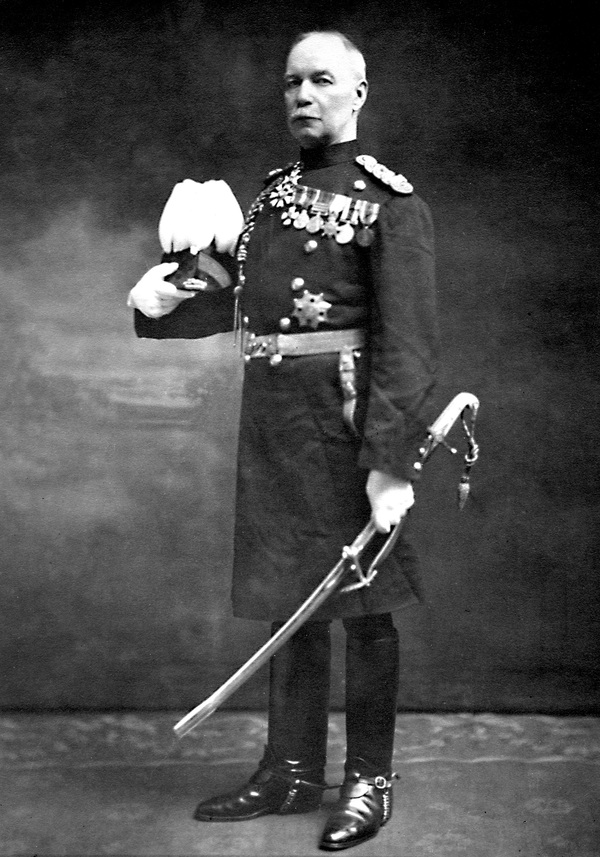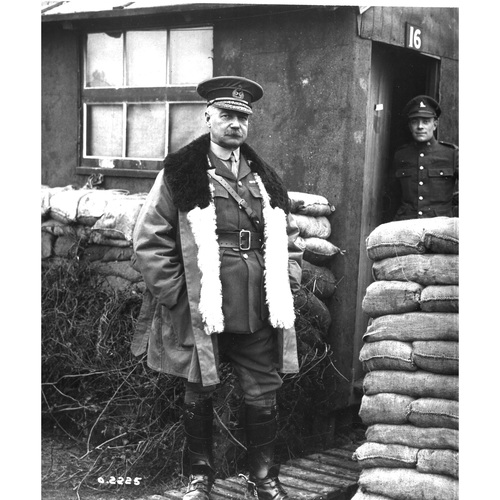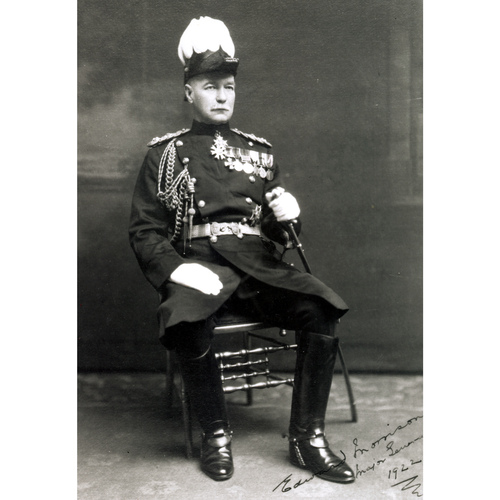
Source: Link
MORRISON, Sir EDWARD WHIPPLE BANCROFT, journalist, militia and army officer, and author; b. 6 July 1867 in London, Ont., third son of Alexander R. Morrison and Jean Campbell; m. 16 Jan. 1911, in New York City, Emma Thacker Kaye (d. 11 Oct. 1936), former wife of Charles Downing Fripp; they had no children; d. 28 May 1925 in Ottawa and was buried there in Beechwood Cemetery.
Edward W. B. Morrison was educated at schools in Galt (Cambridge) and Hamilton, Ont. His first career, beginning in 1888 or 1889, was as a journalist with the Hamilton Spectator, where he rose to be city editor. One example of his work was a four-column article in 1896 entitled “Ten thousand islands: camping experiences on the Rocks of Georgian Bay.” It described a trip through “the Rocks” from Penetanguishene up the east coast of Georgian Bay for 100 miles or so, an area that had been completely surveyed only a few years before. In keeping with his rather rugged world-view he commented, “It is said that if you scratch a Russian you will find a Tartar, but it is also as true that if you scrape the thin veneer of civilisation on the modern man you find him the same stuff as his aboriginal ancestors.”
On 1 July 1898 Morrison joined the Ottawa Citizen as its editor-in-chief, and he would remain with this paper until 1913. Replacing Hugh Clark, described a quarter-century later as “not a great editor,” Morrison left a better impression on his colleagues. One of them would later characterize him as “a pungent writer, with an uncompromising style, a bonnie fighter in the journalistic field as afterwards he proved himself to be on the field of battle – a man with the most comprehensive knowledge of newspaper work in all its phases,” though admittedly this judgement was heavily influenced by hindsight. As an example of his management style, the same colleague recalled that “on Sunday afternoons he used to line us up, not for a symposium on the holy evangels but for a practical talk on the science of gathering news, on literary style and construction and on the fundamental ethics of journalism. He was a stern master in a way and at times he put the subordinate staff over a rough road, but always for our benefit.”
Coincidentally, and very much in keeping with his personality, Morrison served as an artillery officer in Canada’s militia. He had joined the 4th Field Battery in Hamilton, as a second lieutenant, in May 1897 and then transferred to the 2nd Field Battery in Ottawa in 1898, with the rank of lieutenant. In 1899 he obtained a leave of absence from the Citizen to serve in South Africa, where he took part in operations in the Transvaal, the Orange River Colony, and the Cape Colony. After one action in 1900, when he was under the command of Lieutenant-Colonel François-Louis Lessard, he was among five Canadians to be recommended for a decoration, in his case “for the skill and coolness with which he worked and finally saved his guns” in a hasty retreat. He received the Distinguished Service Order the following year. Morrison described his experiences in a volume entitled With the guns in South Africa (1901), providing observations on food, the cold (which came as a surprise to Canadian troops), fellow officers such as Lieutenant John McCrae*, and the nature of operations, especially line of communication work, harassment by Boer commandos, and the occasional battle. The book is, in fact, an excellent source for those interested in the day-to-day life and work of an artillery battery in the South African War. Its last entry encapsulates the military ethos with which Morrison was imbued, reading simply that he had had “a nice time at the war.”
After returning from South Africa, Morrison continued to serve as a reservist until 1913, when he joined the Permanent Force as a lieutenant-colonel and director of artillery. With the outbreak of war in 1914 he went overseas with the first contingent of the Canadian Expeditionary Force, in command of the 1st Brigade, Canadian Field Artillery; John McCrae gave him his medical exam. After serving in the second battle of Ypres in April–May 1915, he reported how impressed he was with the coolness of his gunners in engagements that cost the 1st Canadian Division a third of its 18,000 troops. Then came Festubert and Givenchy-lez-La Bassée. Morrison was promoted brigadier-general on 13 Sept. 1915, to command the artillery of the 1st Canadian Division; in October he was appointed to command the 2nd Divisional Artillery. In this capacity he served through the battles of Saint-Eloi (Sint-Elooi), Sanctuary Wood, and Hooge, and through the bloody offensive along the Somme. On 18 Dec. 1916 he was made the general officer commanding the artillery of the Canadian Corps, a position he held during the battles of Vimy Ridge and Hill 70, which proved more successful, and less costly, than previous engagements. On 15 Aug. 1917, after gunners had expended prodigious amounts of ammunition supporting the infantry as it defended newly captured positions against counter-attacks, a staff officer from the British 1st Army noted that its commander was “appalled” at such profligacy. “So are the Germans,” was Morrison’s reply. He continued to serve as GOC artillery through the battles of Lens and Passchendaele, and the final offensives of 1918. He was promoted major-general on 31 July 1918.
After the war Morrison returned to Canada. He was awarded a kcmg in June 1919. Later that year he became a member of a committee appointed to reorganize the militia [see Sir William Dillon Otter]; he also became deputy inspector-general of artillery. It fell to him to make the controversial announcement, in February 1920, that 16 artillery officers who had served as brigadiers-general overseas would become artillery brigade commanders in Canada, possibly superseding officers who had remained at home to recruit and train gunners for the battlefields of France and Belgium. Morrison became master-general of the ordnance in 1920 and served as adjutant-general in 1922–23. He retired in 1924 and died in Ottawa the following year.
Morrison’s article on the islands of Georgian Bay appears in the Hamilton Spectator, 21 Aug. 1896: 5; his With the guns in South Africa was published in Hamilton in 1901.
AO, RG 80-8-0-988, no.9403. NA, RG 150, Acc. 1992–93/166, box 6403–49. Ottawa Citizen, 19 Jan. 1911, 28 May 1925. “25 years ago the Citizen came under its present ownership and entered evening newspaper field,” Ottawa Citizen, 25 Nov. 1922. Can., Dept. of Militia and Defence, Militia list (Ottawa), 1897–1925. Directory, Hamilton, 1888/89. G. W. L. Nicholson, The gunners of Canada; the history of the Royal Regiment of Canadian Artillery (2v., Toronto, 1967–72). Standard dict. of Canadian biog. (Roberts and Tunnell). W. S. Wallace, Macmillan dictionary of Canadian biography, ed. W. A. McKay (4th ed., Toronto, [1978]), 597.
Cite This Article
William Rawling, “MORRISON, Sir EDWARD WHIPPLE BANCROFT,” in Dictionary of Canadian Biography, vol. 15, University of Toronto/Université Laval, 2003–, accessed April 30, 2025, https://www.biographi.ca/en/bio/morrison_edward_whipple_bancroft_15E.html.
The citation above shows the format for footnotes and endnotes according to the Chicago manual of style (16th edition). Information to be used in other citation formats:
| Permalink: | https://www.biographi.ca/en/bio/morrison_edward_whipple_bancroft_15E.html |
| Author of Article: | William Rawling |
| Title of Article: | MORRISON, Sir EDWARD WHIPPLE BANCROFT |
| Publication Name: | Dictionary of Canadian Biography, vol. 15 |
| Publisher: | University of Toronto/Université Laval |
| Year of revision: | 2005 |
| Access Date: | April 30, 2025 |





